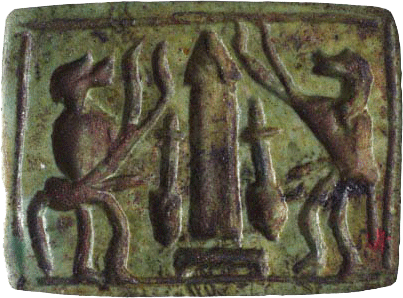Grants Support Object-Based Teaching
Established in 2008, the Andrew W. Mellon Fund for Faculty Innovation at the Princeton University Art Museum encourages innovative curricular initiatives that use the Art Museum’s collections in significant ways. The fund provides grants to faculty members, who then conduct research on the collections or exhibitions in preparation for incorporating object-based learning into new or existing courses. The program was established through an endowment from the Andrew W. Mellon Foundation as part of the Foundation’s ongoing commitment to strengthening the role of academic art museums in the teaching and training of undergraduate and graduate students. For the 2013–14 academic year, the Art Museum has awarded grants to the following faculty members:
Kate Liszka, lecturer, Council of the Humanities and Department of Art and Archaeology, and Cotsen postdoctoral fellow, Society of Fellows, for a fall 2013 undergraduate lecture course on ancient Egyptian archaeology. Students will visit the Art Museum over the course of the semester to study objects on view in the galleries as well as the Art Museum’s collection of scarab-shaped amulets. Students’ findings will further our knowledge of this yet-unstudied area of the collection and will be incorporated into the Museum’s collections database. “Often, when students look at photographs or maps of objects in class, vital details are lost to them, such as the technology used to create an object or how the object’s physical presence and materiality interacted with its archaeological context,” says Liszka. “Seeing a range of works in person provides basic tactile and visible experience for a student to think analytically about such objects.” A specialist in Egyptology and Egyptian archaeology, Liszka holds a Ph.D. in Near Eastern languages and civilizations from the University of Pennsylvania.
Effie Rentzou, assistant professor, Department of French and Italian, for a spring 2014 upper-level undergraduate seminar on poetry and the arts. In this course, students will investigate connections between poetry and the visual arts of the French modernist and avant-garde traditions from the late nineteenth to mid-twentieth century. The Art Museum’s collection of French paintings, prints, and drawings of this period will serve as a starting point for conversations about visual paradigms for poetry, the poet as critic, and other themes. Rentzou will build on the research she conducted for the Museum’s spring 2013 exhibition 1913: The Year of Modernism, organized in collaboration with Calvin Brown, associate curator of prints and drawings. “This was a moment in French poetry that was decisively marked by a turn toward the visual arts,” says Rentzou. “The collections of the Art Museum will be central to students’ exploration of the dialogues between artists and poets at this time.” A specialist in French literature of the avant-garde and its relationship to other arts, Rentzou is currently at work on her second book, titled Concepts of the World: Avant-Garde and the Idea of the International.
Zahid Chaudhary, associate professor, Department of English, for a fall 2013 freshman seminar on “difficult” art. The course will foster first-year students’ skills in visual and media literacy and will ask them to consider the ways in which different media can enable or restrict the representation of ideas that might be deemed impossible to represent—such as violence, absence, or ecstasy. “This course is the result of my research for my next book project, but it has also grown out of my previous experience bringing my students to look at a photography exhibition at the Art Museum,” says Chaudhary. “The course was a junior seminar in the English department, so the students were new to writing about photography. Yet at the end of the semester they all agreed that this was the most interesting assignment they had in the course.” In this seminar, students will confront works from across the history of art, from Goya’s print series The Disasters of War to recent acquisitions by contemporary artists Regina José Galindo and Laurel Nakadate. A specialist in postcolonial studies, visual culture, and critical theory, Chaudhary is the author of Afterimage of Empire: Photography in Nineteenth-Century India (University of Minnesota Press, 2012).
 The Art Museum is funding three additional courses this fall through an “Activating the Collections” grant from the Andrew W. Mellon Foundation: “The Art of Insignificance,” an undergraduate seminar taught by André Benhaïm, associate professor, Department of French and Italian; “The Itinerant Languages of Photography,” an undergraduate seminar taught by Gabriela Nouzeilles, professor and chair, Department of Spanish and Portuguese; and a graduate seminar of the same name, taught by Eduardo Cadava, professor, Department of English.
The Art Museum is funding three additional courses this fall through an “Activating the Collections” grant from the Andrew W. Mellon Foundation: “The Art of Insignificance,” an undergraduate seminar taught by André Benhaïm, associate professor, Department of French and Italian; “The Itinerant Languages of Photography,” an undergraduate seminar taught by Gabriela Nouzeilles, professor and chair, Department of Spanish and Portuguese; and a graduate seminar of the same name, taught by Eduardo Cadava, professor, Department of English.
Johanna Seasonwein
Andrew W. Mellon Curatorial Fellow for Academic Programs
